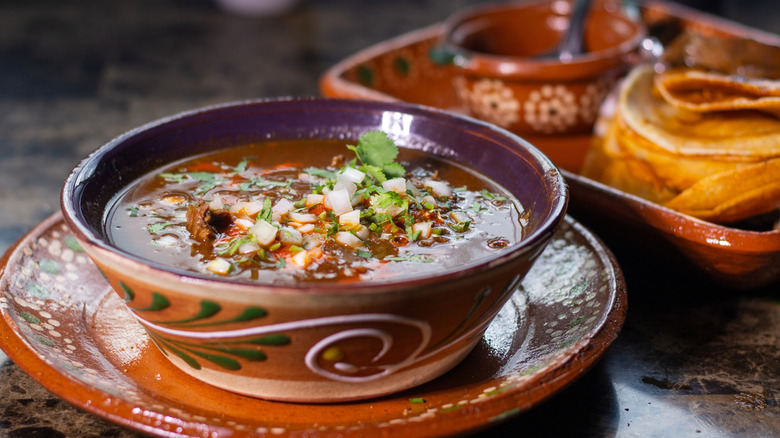The Unexpected Condiment You Should Be Adding To Your Mexican Dishes
There's a secret ingredient that makes micheladas, marinades for carne asada, and caldos so rich. You likely wouldn't be able to identify its salty, umami flavor right away, and you might even guess that it's soy sauce — and actually, it shouldn't necessarily be the main flavor in a dish, but rather an enhancer of other flavors. Enter Maggi seasoning sauce.
Although it is commonly used in Mexican cuisine, Maggi seasoning sauce is a dark, concentrated liquid flavoring originally developed in Switzerland in the late 1800s. Though it looks like soy sauce and can be used as its alternative, it's not made from soy, but rather wheat protein that's been hydrolyzed to produce a rich, umami-heavy flavor. It's salty and savory with somewhat meaty hints, and has a viscosity similar to Worcestershire sauce.
In Mexico, Jugo Maggi, as it's called there, has become a staple condiment, found in home kitchens to restaurant tables right next to salsa. Every country that sells Maggi has a slightly different variation — in the Philippines, the product contains more garlic, and in Africa and the Caribbean, the cubed version of Maggi is more popular. It's loved throughout the world for both how it enhances flavor in cooking and as a finishing touch on dishes like rice, eggs, and pasta.
How to use Maggi sauce in Mexican dishes
Before adding Maggi to a dish, consider the dish's existing salt content — this seasoning contains salt, so you don't want to go overboard. In fact, the company itself suggests using only a few drops in your dishes. The key is not to be able to taste the Maggi — the flavor of the seasoning should quietly blend in, while adding a subtle richness and complexity to the other present flavors.
Maggi is a flavor that can really amp up a classic Michelada recipe. A few dashes of Maggi add umami and depth, balancing the lime juice, hot sauce, and beer. It can be used to replace Worcestershire sauce, or alongside it (but sparingly). Add a splash to caldo de res (beef soup), pozole, or sopa de lentejas (Mexican lentil soup) to bring out a deeper broth flavor.
Marinades for carne asada, pollo asado, or pork can benefit from Maggi. Mix it with lime juice, garlic, cumin, and chili powder for a well-balanced flavor base. It's especially good for vegetarian taco fillings that benefit from more umami; sprinkle a little on grilled mushrooms, sautéed peppers, or onions. Using a few drops of Maggi in citrus-cured seafood dishes, like aguachile or ceviche, adds a touch of richness against the light, refreshing flavors.

